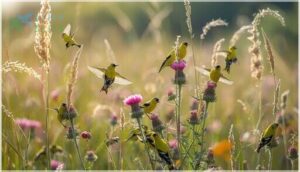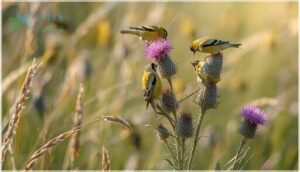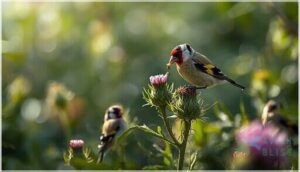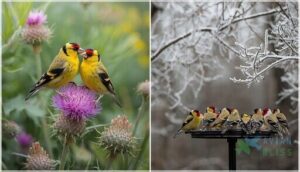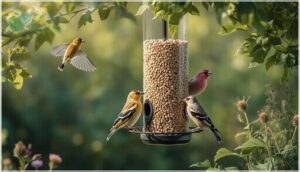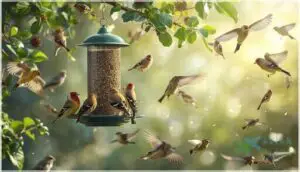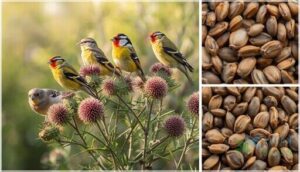This site is supported by our readers. We may earn a commission, at no cost to you, if you purchase through links.
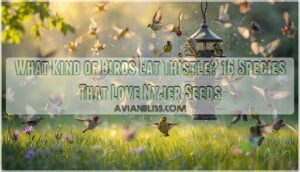
A single goldfinch can strip a thistle feeder clean in an afternoon, leaving you wondering where all the seeds went—and who else might be joining the feast. Thistle seed, especially Nyjer, isn’t just a snack; it’s a lifeline for finches, siskins, and redpolls, powering their migration and winter survival.
If you’ve ever watched a blur of yellow and black fluttering outside your window, you’ve witnessed the quiet competition for these oil-rich seeds. Understanding what kind of birds eat thistle can transform your backyard into a hub for some of the most vibrant and active species around.
Table Of Contents
- Key Takeaways
- What Birds Eat Thistle Seed?
- Goldfinches: Top Thistle Seed Consumers
- Finches That Love Thistle Seeds
- Other Birds Attracted to Thistle Feeders
- Thistle Seed Nutrition and Bird Health
- How to Attract Thistle-Eating Birds
- Frequently Asked Questions (FAQs)
- Why do birds eat thistle seeds?
- How do I attract birds that eat Thistle?
- Are thistles good for birds?
- Do redpolls eat thistle seeds?
- What is thistle seed?
- Do I need a bird feeder for Nyjer (thistle) seeds?
- What birds eat thistles?
- Why won’t the birds eat my thistle?
- Will squirrels eat thistle?
- Can I put thistle seed in a regular bird feeder?
- Conclusion
Key Takeaways
- Goldfinches, finches like House Finch, Purple Finch, Pine Siskin, Common Redpoll, and sparrows are the main birds attracted to thistle (Nyjer) seeds, using them as a vital food source especially during migration and winter.
- Thistle seed feeders also draw in buntings, some woodpeckers, doves, grosbeaks, and blackbirds, though these species usually consume thistle as a minor part of their diet compared to finches.
- Thistle and Nyjer seeds are rich in protein and fat, providing essential energy and nutrients that support bird health, feather growth, and successful breeding.
- Choosing the right feeder design and offering fresh seeds will attract a wider variety of thistle-eating birds and help maintain healthy backyard populations.
What Birds Eat Thistle Seed?
If you’re wondering which birds will visit your thistle feeder, you’ll be pleased to know there’s a surprisingly diverse lineup. While goldfinches get most of the attention, they’re far from the only species that rely on these tiny, oil-rich seeds.
Let’s look at the main groups of birds you can expect to see at your thistle feeders throughout the year.
Goldfinches and Their Thistle Diet
Goldfinches are the champions of thistle consumption, deriving over 95% of their diet from seeds, with Nyjer seeds as their top choice. Their feeding behavior intensifies during late summer when thistle plants ripen.
These finches time their nesting to coincide with thistle availability, using thistle down for nest lining while feeding their young exclusively on these oil-rich seeds—a unique trait among songbirds. They’re easily recognized by their gold and black plumage during the summer.
Finches That Prefer Thistle
Beyond goldfinches, you’ll find House Finches dominating thistle feeders—they make up 28% of feeder visitors and consume up to 1.2 grams daily. Purple Finches show a 42% activity boost with fresh Nyjer seeds, while Pine Siskins rely on thistle for 87% of winter consumption.
Nyjer seed’s popularity stems from its appeal to backyard bird enthusiasts. Common Redpolls gather in flocks of 10-30 during cold snaps, extracting 85% of available energy from these oil-rich seeds.
Sparrows That Consume Thistle
You’ll notice Song Sparrows and White-throated Sparrows readily visit Nyjer feeders, though they’re less efficient than finches—taking 4.5 seconds per seed versus 3 for millet.
These seed-eating birds rely on plant seeds for 86% of winter diets, boosting yard populations from 0.85 to 1.89 birds during cold months.
Quality thistle seeds can advance their nesting by up to 14 days.
Woodpeckers Eating Thistle Seeds
While sparrows linger at Nyjer feeders, woodpeckers show up less often for thistle seeds. Their Dietary Proportion of thistle is minor—usually under 5%. Feeder Access isn’t ideal for larger bills, so you’ll spot Downy or Red-bellied Woodpeckers mainly during Seasonal Foraging in winter.
Regional Differences matter, too; northern woodpeckers supplement their Seed Preference when insects run scarce.
Buntings and Thistle Consumption
Buntings, with their vibrant plumage, show a clear habitat correlation with thistle-rich areas, especially during late summer and autumn.
You’ll spot seasonal spikes in their visits to feeders offering Nyjer seeds. Their dietary proportion of thistle seeds climbs outside breeding months, boosting nutritional benefits like energy for migration.
Feeder attractiveness rises when thistle blends are refreshed regularly.
Doves and Grosbeaks at Thistle Feeders
Curiosity about seedeating birds leads you to doves and grosbeaks, both drawn to thistle seeds in unique ways. You’ll see these species respond to:
- Doves Seed Preference for Nyjer in ground-level feeders
- Grosbeak Winter Visits during scarcity
- Feeder Design Impact on access
- Seasonal Consumption Trends boosted by a Blended Seed Strategy
Their feeding habits shift with weather and seed availability.
Blackbirds Feeding on Thistle
Among seedeating birds, blackbirds stand out for their flexible bird feeding habits. While their seed preference leans toward grains, you’ll sometimes spot them at Nyjer seed feeders, especially during seasonal spikes when other foods run low.
Feeder visitation by blackbirds remains a minor dietary component, and thoughtful feeder management—like using small-port thistle feeders—can further limit their access.
Goldfinches: Top Thistle Seed Consumers
Goldfinches are famous for their love of thistle seeds, showing up wherever these plants grow.
If you want to know what sets each goldfinch species apart, it helps to look closer at their feeding habits. Here’s what you’ll find when you compare their preferences throughout the year.
American Goldfinch Feeding Habits
Ever wondered why American Goldfinches flock to thistle feeders so eagerly? Their seed preferences lean heavily toward thistle and Nyjer seeds, driving their acrobatic foraging behavior in weedy fields. You’ll notice three things:
- Over 90% of their diet is seeds.
- Seasonal shifts match thistle blooming.
- Habitat correlation favors open, wildflower-rich landscapes.
Lesser Goldfinch Preferences
Picture Lesser Goldfinches twisting and hanging upside down on thistle heads—these finches are true acrobats. Their foraging behavior centers on seed selection, with Nyjer and thistle seeds topping the menu.
Dietary variation is minimal: over 80% choose thistle when available. Thistle impact is clear, driving flock size, migration timing, and population dynamics across western habitats.
European Goldfinch Thistle Consumption
Did you know the European Goldfinch’s very name—Carduelis carduelis—derives from the Latin for thistle? These finches rely on thistle seeds as a true dietary staple, using their specialized beaks to extract seeds efficiently.
In garden feeders, their seed preference is clear: Nyjer and thistle seeds always win out, especially among seed-eating bird species during the breeding season.
Seasonal Variations in Goldfinch Diet
Just as European Goldfinches favor thistle, American Goldfinches show a marked Summer Seed Specialization. Their Breeding Thistle Link means nesting peaks when thistle seeds ripen, fueling both adults and nestlings.
In Winter months, you’ll notice Winter Diet Shifts—goldfinches and finches flock to feeders for Nyjer seeds, adjusting their Nestling Trophic Strategy for energetic implications and survival.
Finches That Love Thistle Seeds
Finches are some of the most frequent visitors at thistle feeders, each with its own feeding style. If you’re curious which finch species favor these seeds, you’re in the right place.
Let’s look at a few that stand out for their love of thistle.
House Finch Thistle Eating Behavior
You’ll often spot House Finches flocking to tube feeders packed with thistle seeds or nyjer, especially in winter when food is scarce. Their feeder preferences lean toward designs that minimize waste.
Foraging rates spike during cold snaps, and thistle’s nutritional impact—high oil and protein—helps maintain body mass. These seed-eating birds drive local population trends wherever thistle is reliably available.
Purple Finch Attraction to Thistle
Just like House Finches, Purple Finches show a marked Nyjer Seed Preference, especially during colder months. Their Winter Diet Reliance on thistle seeds is clear—these energy-rich seeds boost Feeder Appearance rates. Irruption Cause ties back to seed availability, and Juvenile Nutrition depends heavily on thistle. If you’re attracting birds, Purple Finches respond well to Nyjer-filled feeders.
- Nyjer Seed Preference
- Winter Diet Reliance
- Irruption Cause
- Juvenile Nutrition
- Feeder Appearance
Pine Siskin’s Affinity for Thistle
Now, if you’ve watched Pine Siskins at your feeder, you know their Winter Thistle Reliance is unparalleled. These finches swarm Nyjer seed, sometimes outnumbering other species—especially during Irruptive Migration Patterns.
Seed Preference Factors drive their Feeder Dominance Dynamics, and conservation implications are clear: thistle seeds help Pine Siskins survive harsh winters, fueling energy reserves and supporting flock health.
Common Redpoll Feeding Patterns
Common Redpolls quickly adapt their Winter Seed Preference, especially when Nyjer and thistle seeds are available. Thanks to Diverticulum Food Storage, they gather seeds in flocks, outpacing other finches during Irruptive Migration Impact. You’ll notice their acrobatic Foraging Flock Behavior and Feeder Competition—sometimes besting Pine Siskins for access.
Here’s what sets redpoll feeding apart:
- Rapid seed collection
- Diverticulum storage
- Competitive flock feeding
- Flexible feeder use
- Migration-driven foraging
Other Birds Attracted to Thistle Feeders
Thistle feeders don’t just attract finches and goldfinches. You’ll notice other birds showing up for a share of the seeds, too.
Here are a few species you’re likely to see joining the feast.
Sparrows and Their Thistle Preferences
Ever noticed sparrows skipping over Nyjer seed at your feeder? That’s thistle aversion in action. Sparrows favor larger seed size and compete with finches for prime picks. Their seasonal diet leans toward millet and sunflower, meeting nutritional needs better than thistle seed. Still, ground-feeding sparrows may sample thistle, especially when feeding competition leaves fewer options.
| Seedeaters | Thistle Preference |
|---|---|
| Sparrows | Low |
| Finches | High |
| Seed Size | Larger Favored |
| Feeding Comp. | Limits Thistle |
Dark-eyed Junco Thistle Consumption
Ground foraging defines Dark-eyed Junco winter diet—these seed-eating bird species rarely perch at finch feeders but thrive on thistle seed scattered beneath.
Smart feeder placement near shrubs boosts habitat use, drawing juncos for supplemental feeding. If you want to support their bird feeding habits, offer nyjer on the ground; you’ll see steady visits all season.
Chickadee and Titmouse Occasional Feeding
Did you know chickadees and titmice treat Nyjer seed as a backup snack, not their main course? Their foraging behavior shifts in winter, when thistle seeds help fuel high energy needs. While finches flock to Nyjer, these generalists dip in occasionally.
For attracting birds, mix Nyjer with sunflower—management implications show diversity wins over single-seed offerings for both species.
Thistle Seed Nutrition and Bird Health
Thistle seeds pack a lot of nutrition for birds, fueling everything from migration to nesting. If you’re curious about what’s inside these tiny seeds, you’ll find they offer more than just a quick snack.
Here’s a look at the nutrients and benefits that make thistle so important for bird health.
Protein and Fat Content in Thistle Seeds
Thistle seeds pack a punch regarding protein ratios and fat composition. Varieties like Nyjer offer 16% protein and 25% fat, ideal for finches and other birds needing a dense energy source.
Thistle seeds deliver high protein and fat, making them a powerhouse energy source for finches and similar birds
This nutritional value of seeds aids bird growth and feather development, making thistle a smart choice for boosting health in your backyard visitors.
Essential Minerals and Energy Benefits
Looking for a real nutritional powerhouse for your backyard flock? Thistle seeds deliver essential nutrients like calcium, magnesium, and iron—key for bird wellness and strong eggshells.
Their energy-rich oils pack 480 kcal per 100 g, fueling finches and goldfinches through cold snaps and migration. Seasonal consumption and dietary supplementation help birds get a boost in health and vitality.
Importance of Thistle in Bird Development
With thistle seeds powering everything from chick growth to feather development, you’re giving finches and goldfinches a real head start. Nyjer seed’s nutritional benefits—like energy provision and immune function—show up in stronger muscles and denser bones. For birds, it’s a difference you can see:
- Rapid chick growth
- Sturdy feather development
- Improved immune function
- Enhanced skeletal health
How to Attract Thistle-Eating Birds
If you want more thistle-eating birds in your yard, a few simple changes can make a big difference. The right setup brings finches, sparrows, and others flocking in. Here’s how you can create a space they won’t want to leave.
Best Thistle Feeder Types and Designs
Curiosity leads many bird enthusiasts to compare tube feeder design with sock feeder benefits and mesh feeder hygiene. You’ll find tube feeders excel in durability and squirrel-proof features, while mesh feeders offer easy cleaning and airflow. Sock feeders mimic natural thistle heads, attracting finches. Regular feeder maintenance keeps seeds fresh and birds healthy.
| Feeder Type | Key Benefit |
|---|---|
| Tube Feeders | Squirrel-proof, durable |
| Sock Feeders | Natural feeding mimicry |
| Mesh Feeders | Hygiene, airflow |
Planting Thistles in Your Yard
Once you’ve picked a feeder, planting thistles offers another way to attract backyard birds. Choose native thistle species for your garden location, and prepare soil with good moisture and light for best seed germination.
Western thistle fits dry spots, while Brewer’s swamp thistle thrives in wetter areas. Regular maintenance keeps thistles healthy, drawing finches and other birds year after year.
Tips for Maintaining Bird-Friendly Environments
After planting thistles, creating a bird-friendly environment means more than just seeds. You’ll want to focus on:
- Clean water sources—weekly scrubbing keeps backyard birds healthy.
- Feeder hygiene—regular bird feeder maintenance limits disease risk.
- Safe shelter and pet management—dense shrubs and keeping cats indoors protect nesting birds.
These bird feeding tips help attract more species to your yard.
Frequently Asked Questions (FAQs)
Why do birds eat thistle seeds?
Imagine a pantry stocked with the most nutritious seeds—Nyjer and thistle offer just that for finches and songbirds.
Their nutrient density, rich oils, and protein fill essential seasonal needs, driving birds’ feeding specialization and seed preference.
How do I attract birds that eat Thistle?
Attracting birds to your yard starts with offering fresh thistle seeds in a proper finch feeder.
Place the feeder near native plants and water sources, control predators, and keep seed quality high by cleaning feeders regularly.
Are thistles good for birds?
Thistle seeds—often sold as Nyjer—deliver nutritional benefits, including protein and healthy fats that boost digestive health, immune support, feather quality, and bone strength.
For finches and others, attracting birds with thistle can improve overall wellness.
Do redpolls eat thistle seeds?
If you think seedeating birds are choosy, think again: redpolls strongly favor thistle seed (Nyjer) at feeders, making them regular winter guests.
Their redpoll feeding behavior and irruptive migration patterns highlight a clear Redpoll seed preference.
What is thistle seed?
You’ll often see “thistle seed” sold for wild birds, but it’s usually Nyjer—tiny black seeds from an African plant.
Unlike native thistle, Nyjer is heat-sterilized, high in fat, and perfectly suited for finch species and other seedeaters.
Do I need a bird feeder for Nyjer (thistle) seeds?
As the saying goes, “the right tool for the job,” and a Thistle Feeder with small feeder port size is essential for Nyjer.
Tube feeders reduce seed waste, boost finch visits, last longer, and lower predator ambush sites.
What birds eat thistles?
You’ll spot Goldfinches, various finches, sparrows, buntings, and even woodpeckers enjoying thistle seeds.
Thistle seed benefits draw in diverse seedeating bird species, encouraged by specialized finch beak adaptations and the right thistle feeder types.
Why won’t the birds eat my thistle?
If birds aren’t touching your thistle or Nyjer seed, it’s likely due to seed freshness, poor feeder placement, seed competition, seasonal effects, or changes in bird behavior—sometimes the seed spoils, or other foods simply win out.
Will squirrels eat thistle?
It might surprise you, but most squirrels show little interest in thistle seeds—Squirrel Thistle Preference is low. Thanks to the poor Thistle Nutritional Value, Squirrel Feeding Habits usually favor richer options. Thistle Feeder Deterrents help, though seeds can attract other rodents.
Can I put thistle seed in a regular bird feeder?
Putting thistle seeds in a regular bird feeder often leads to seed spillage and feeder waste. Tube feeders or specialized finch feeders with small ports protect thistle seed, improving bird access and matching the seed preference and feeder design.
Conclusion
Choosing thistle for your feeder is like setting a table for specialists—each guest, from goldfinches to siskins, brings its own unique appetite. By recognizing what kind of birds eat thistle, you attract a constellation of yellow and streaked visitors, but also support their migrations and daily routines.
With each refill, you become part of a subtle ecological dance, connecting with birds whose lives revolve around this small, dark seed and the vitality it provides.
- https://shop.jacobijayne.com/blogs/news/do-finches-prefer-thistle-or-nyjer-seed
- https://www.allaboutbirds.org/guide/Pine_Siskin/overview
- https://soar.suny.edu/bitstreams/da056c3f-d49c-453e-9b87-851c38ca1097/download
- https://xerces.org/sites/default/files/2018-05/16-029_01_XercesSoc_Native-Thistles-Conservation-Guide_web.pdf
- https://www.audubon.org/magazine/whats-deal-nyjer

